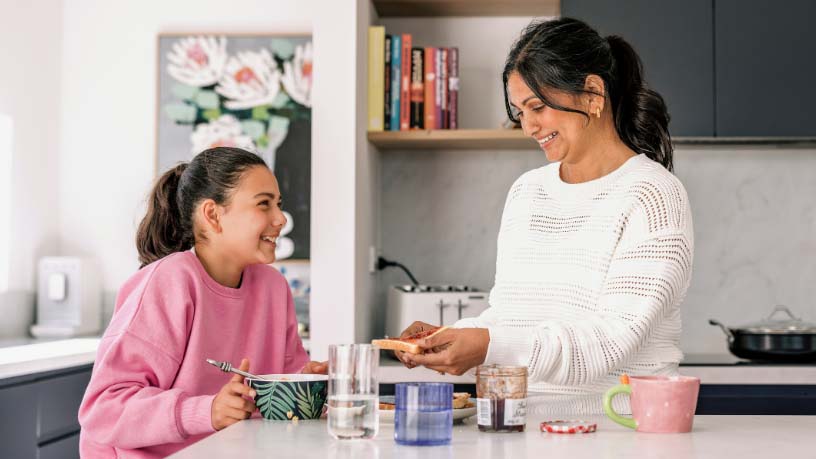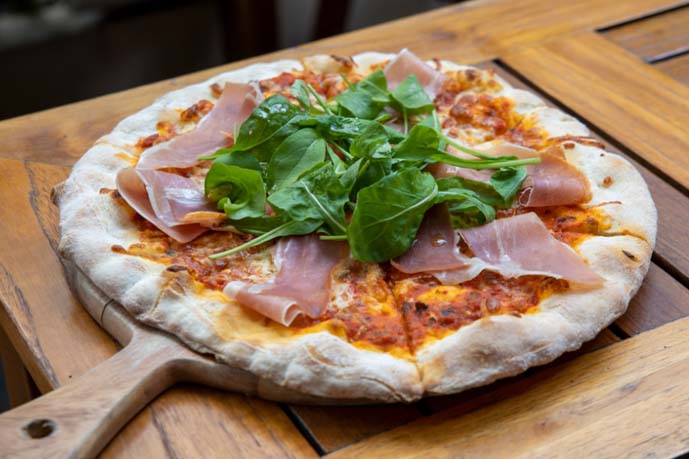Sugar cravings can be caused by lifestyle factors (like not getting enough sleep), mood and more.
Key takeaways
You can keep your energy levels stable with low GI and high fibre foods.
Find out how to fight your sugar cravings with 8 simple tips.
If you find yourself heading to the vending machine or raiding the kids’ lolly stash at 3pm, you could be suffering from sugar cravings.
Caused by everything from lack of sleep, low blood sugar levels and even boredom, giving in to sugar cravings can derail healthy habits and lead to bigger energy slumps later in the day.
Learn how to recognise a sugar craving and what to do when it strikes.
What are sugar cravings?
Many of us have experienced sugar cravings. Though often associated with mid-afternoon energy slumps, sugar cravings can strike at any time and can even last the whole day.
When sugar cravings hit, we tend to reach for highly refined, high in fat and highly processed foods (hello: biscuits, chocolate and that secret stash of lollies at the top of the pantry).1
While these foods might give us the sugary hit we’re looking for in the short-term, they can actually cause our blood sugar levels to spike and drop quickly, making us crave more sugar and consequently creating a sugar-craving cycle.2
What causes sugar cravings?
Conditioning
When we eat foods high in added sugar it stimulates the brain’s reward system and makes us feel happier and less stressed.3 Over time we condition ourselves to reach for these high sugar foods when we’re feeling tired, anxious or unhappy. This creates a sugar craving cycle: we feel stressed or unhappy, we eat something sweet, feel better and then repeat.
Low blood sugar levels
When our blood sugar levels drop, we can crave sugar. This happens because our brain’s primary fuel source is glucose, which is a type of sugar. If our brain doesn’t receive adequate amounts of glucose, it can send out signals telling us to grab the nearest sugary treat to feed the brain’s ability to function.
Seeing, smelling or thinking about sweet foods
‘Out of sight, out of mind’ doesn’t always do the trick. When we see, smell or think about sugary foods, it can cause cravings. Not great if you work in an office where cake is an afternoon staple, or the treat cupboard is always fully stocked.
How to stop sugar cravings
Once a sugar craving strikes it can be hard to resist, so laying the groundwork to keep your energy levels stable from morning to night is the key to success.
1. Keep your blood sugar levels stable
Steady blood sugar levels can help prevent sugar cravings. Don’t skip meals and make sure you include low-glycaemic index (GI) food in your meals and snacks. Low GI foods are digested and absorbed slowly by your body, leading to a gradual rise in your blood sugar levels and helping to avoid spikes and drops.4 Low GI foods include oats, legumes, wholegrain bread and quinoa.
2. Eat high-fibre foods
Soluble fibre, which is found in fruit, veggies and grains (like oats, legumes and seeds), swells with water in your gut and helps you feel full.5 It can stabilise your blood sugar levels and help manage your sugar cravings. Try to consume a high fibre food with each meal.
3. Don't keep sweets on hand
While you don’t need to avoid your favourite sweet treats altogether, it can be easier to manage your sugar cravings if you don’t have them in the house. Stock the fridge and pantry with healthy snack options instead, such as unsalted nuts, popcorn, fruit and veggie sticks.
4. Find the reason for your sugar cravings
If you’re eating a healthy, balanced diet, sugar cravings should ease off. If they don’t, you might need to ask why.
If you’re bored or stressed, go for a walk, call a friend, get some fresh air or listen to some music instead of reaching for a snack.
5. Eat protein-based snacks
Protein helps stabilise your blood sugar levels and keeps you feeling full. Include a protein source in your snacks. Low fat Greek yoghurt or a handful of unsalted nuts are great options.
6. Eat some fruit
Fruit includes natural sugars, but thanks to the fibre content your body processes the sugar differently to foods that are high in processed sugar. Healthy amounts (2 pieces of fruit a day is recommended) can help manage your sugar cravings.6
7. Stay active
When a sugar craving hits, try going for a walk. Moving your body releases endorphins and helps increase your serotonin levels, making you feel happier, which helps to reduce cravings. Replacing sugar with another habit such as walking, a gym class or yoga will help to decondition yourself so that your brain no longer associates that time of day or feeling with sugar.7
8. Drink more water
Dehydration can be confused with sugar cravings. If you feel the need for a pack of lollies, drink a big glass of water, wait, and then re-assess.
Member Health Programs
Discover health cover that's right for you with a range of personalised programs and services designed to support your health and wellbeing.

At Bupa, trust is everything
Our health and wellbeing information is regularly reviewed and maintained by a team of healthcare experts, to ensure its relevancy and accuracy. Everyone's health journey is unique and health outcomes vary from person to person.
This content is not a replacement for personalised and specific medical, healthcare, or other professional advice. If you have concerns about your health, see your doctor or other health professional.
1Yanovski, S (2003). Sugar and fat: cravings and aversions. Journal of Nutrition, 133(3), 835S-837S.
2Diabetes Australia. (2022). Ultra-processed foods. What are they and how do they impact health?. Diabetes Australia.
3Ahmed, S. H., Guillem, K., & Vandaele, Y. (2013). Sugar addiction: pushing the drug-sugar analogy to the limit. Current Opinion in Clinical Nutrition & Metabolic Care, 16(4), 434-439.
4Healthdirect. (2022). Glycaemic index (GI). Healthdirect.
5Ayaz, A., Akyol, A., Inan-Eroglu, E., Kabasakal Cetin, A., Samur, G., & Akbiyik, F. (2017). Chia seed (Salvia Hispanica L.) added yogurt reduces short-term food intake and increases satiety: randomised controlled trial. Nutrition Research and Practice, 11(5), 412-418.
6Heart Foundation. (2020). Fruit, vegetables and heart health. Heart Foundation.
7Myers, C. A., Martin, C. K., & Apolzan, J. W. (2018). Food cravings and body weight: a conditioning response. Current Opinion in Endocrinology, Diabetes and Obesity, 25(5), 298-302.
You might also like...
5 easy ways to cut down on sugar
We've all heard about the health risks of eating too much sugar, but is cutting it out completely the answer?
50 healthy food swaps
Small changes to your diet can have a big impact on your health. To make it easy, we’ve put together 50 healthier food swaps you can make for the whole family.
Healthier versions of your favourite comfort food
Eating a healthier diet doesn’t mean you have to give up all your favourite comfort foods. Check out these recipe tips for delicious, nutritious meals.
Road testing the 5:2 diet
I don’t know if it was out of curiosity or solidarity, but I decided to eat my words (they’re calorie free after all) and give the 5:2 diet a go.





